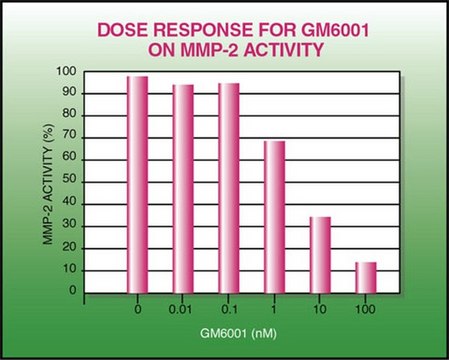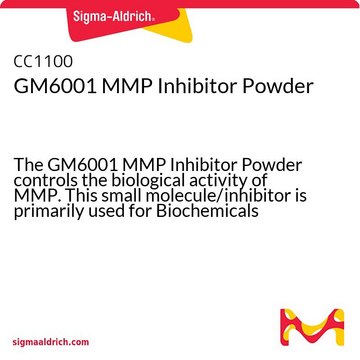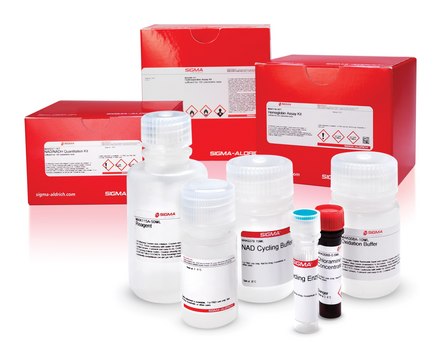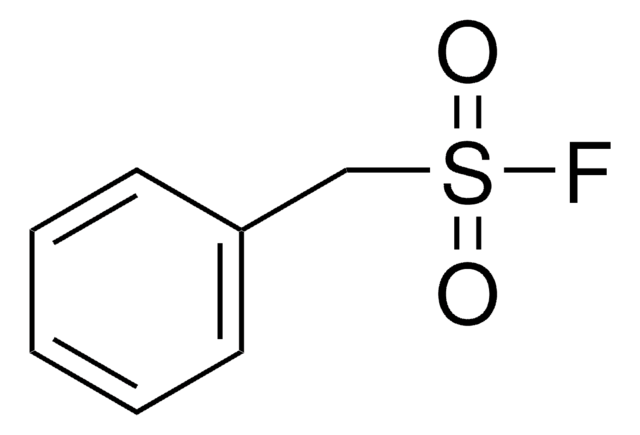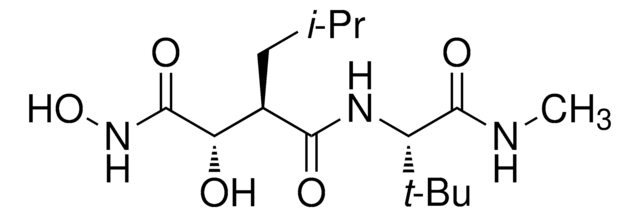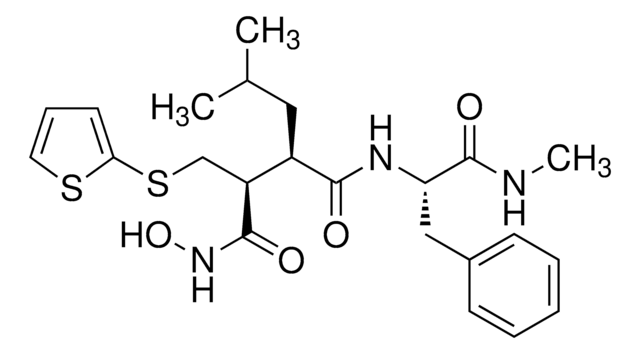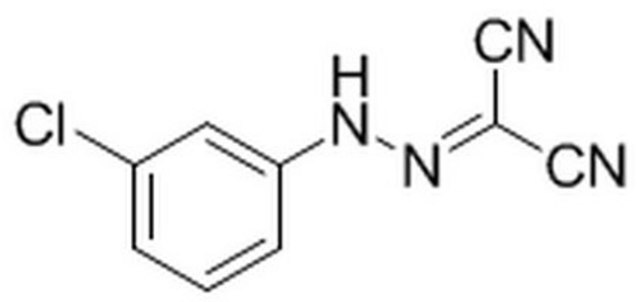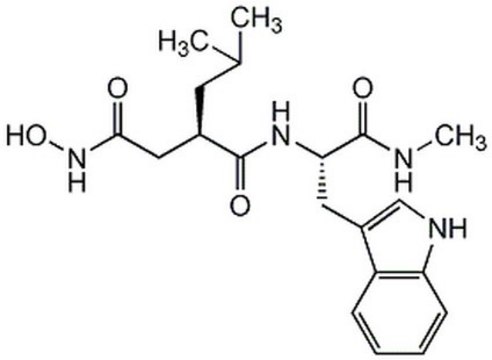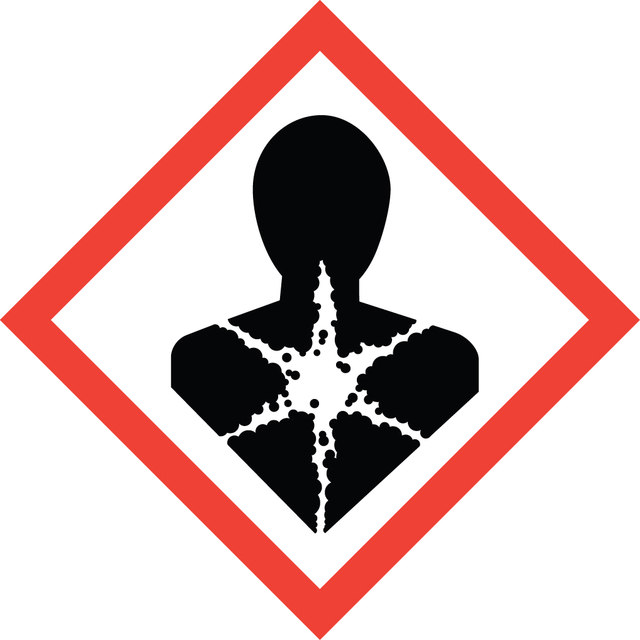PZ0198
普马司他 盐酸盐
≥95% (HPLC)
别名:
(S)-2,2-Dimethyl-4-((p-(4-pyridyloxy)phenyl)sulfonyl)-3-thiomorpholinecarbohydroxamic acid hydrochloride, AG 3340 hydrochloride, AG-3340 hydrochloride, AG3340 hydrochloride
登录查看公司和协议定价
所有图片(1)
About This Item
经验公式(希尔记法):
C18H21N3O5S2 · HCl
CAS号:
分子量:
459.97
UNSPSC代码:
12352200
PubChem化学物质编号:
NACRES:
NA.77
推荐产品
质量水平
方案
≥95% (HPLC)
表单
powder
储存条件
desiccated
颜色
white to beige
溶解性
H2O: 15 mg/mL (clear solution)
储存温度
room temp
SMILES字符串
Cl.CC1(C)SCCN([C@H]1C(=O)NO)S(=O)(=O)c2ccc(Oc3ccncc3)cc2
InChI
1S/C18H21N3O5S2.ClH/c1-18(2)16(17(22)20-23)21(11-12-27-18)28(24,25)15-5-3-13(4-6-15)26-14-7-9-19-10-8-14;/h3-10,16,23H,11-12H2,1-2H3,(H,20,22);1H/t16-;/m0./s1
InChI key
UQGWXXLNXBRNBU-NTISSMGPSA-N
一般描述
Prinomastat comprises hydroxamic acid group and chelates with zinc ion.
应用
Prinomastat hydrochloride has been used as an antagonist for metalloproteinases (MMPs) in Crotalus atrox venom samples and mouse embryo cultures. It may be used as a MMP-2 inhibitor in HepG2 cells.
生化/生理作用
Prinomastat is a matrix metalloprotease (MMP) inhibitor with selectivity for MMPs 2, 3, 9, 13, and 14. Inhibition of these MMPs has been postulated to block tumor invasion and metastasis. It is extremely potent at MMP-3 and MMP-2 with IC50s, 30 pM & 50 pM, respectively.
Prinomastat is a matrix metalloprotease (MMP) inhibitor.
警示用语:
Danger
危险声明
危险分类
Repr. 1B
储存分类代码
6.1C - Combustible acute toxic Cat.3 / toxic compounds or compounds which causing chronic effects
WGK
WGK 3
闪点(°F)
Not applicable
闪点(°C)
Not applicable
法规信息
新产品
历史批次信息供参考:
分析证书(COA)
Lot/Batch Number
Devin W McBride et al.
Journal of neuroscience research, 98(1), 191-200 (2018-09-23)
Hemorrhagic transformation after ischemic stroke is an independent predictor for poor outcome and is characterized by blood vessel rupture leading to brain edema. To date, no therapies for preventing hemorrhagic transformation exist. Disintegrins from the venom of Crotalus atrox have
Anamika Dayal et al.
Nature communications, 8(1), 475-475 (2017-09-09)
Skeletal muscle excitation-contraction (EC) coupling is initiated by sarcolemmal depolarization, which is translated into a conformational change of the dihydropyridine receptor (DHPR), which in turn activates sarcoplasmic reticulum (SR) Ca2+ release to trigger muscle contraction. During EC coupling, the mammalian
A F Dulhunty et al.
Progress in biophysics and molecular biology, 79(1-3), 45-75 (2002-09-13)
Excitation-contraction coupling in both skeletal and cardiac muscle depends on structural and functional interactions between the voltage-sensing dihydropyridine receptor L-type Ca(2+) channels in the surface/transverse tubular membrane and ryanodine receptor Ca(2+) release channels in the sarcoplasmic reticulum membrane. The channels
Hongli Hu et al.
Scientific reports, 5, 8370-8370 (2015-02-11)
Dihydropyridine receptor (DHPR), an L-type Ca(2+) channel complex, plays an essential role in muscle contraction, secretion, integration of synaptic input in neurons and synaptic transmission. The molecular architecture of DHPR complex remains elusive. Here we present a 15-Å resolution cryo-electron
Jin-Kyoung Yang et al.
Nanoscale, 8(24), 12272-12281 (2016-06-09)
Molecule-induced assembly of nanomaterials can alter their unique chemical and physical properties, which can be a promising approach for sensing. Herein, we demonstrate an optical 'turn-on' biosensor for the detection of matrix metalloproteinase-2 (MMP-2), fabricated by means of a peptide-induced
我们的科学家团队拥有各种研究领域经验,包括生命科学、材料科学、化学合成、色谱、分析及许多其他领域.
联系技术服务部门